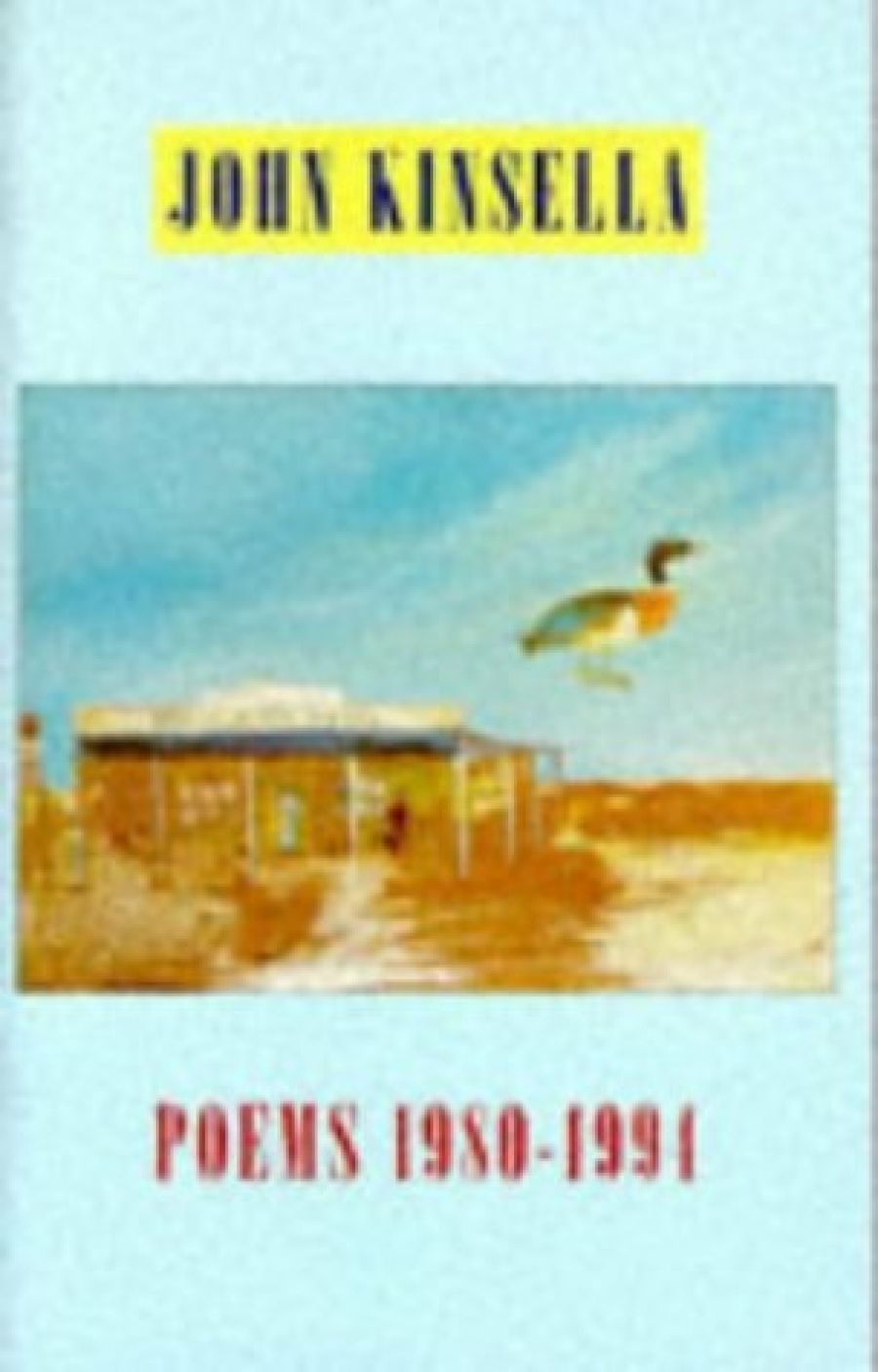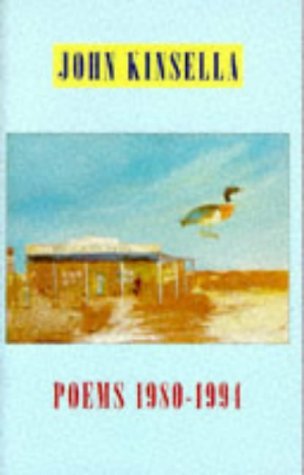
- Free Article: No
- Contents Category: Poetry
- Custom Article Title: Kinsella's Hallmarks
- Review Article: Yes
- Article Title: Kinsella's Hallmarks
- Online Only: No
- Custom Highlight Text: Fremantle Arts Centre Press published its first collection of John Kinsella’s poetry in 1989, only eight years ago.
- Book 1 Title: Poems 1980-1994
- Book 1 Biblio: FACP, $19.95 pb, 346 pp
- Book 1 Cover Small (400 x 600):

How to gauge Kinsella’s achievement? Those who have come in contact with the poet know well that he is a phenomenon, so dedicated to poetry, so mercurial and driven in his profession of it, as to put the normal criteria of judgement into abeyance. Somehow his energy is so overwhelming that it makes the quality of his poetry seem like a secondary consideration.
I wonder whether Kinsella himself hasn’t fallen into this view. In a note to Poems 1980–1994, he declares that it contains ‘all of the poems I wish to preserve in print from this period’ – a modest-sounding claim, until you note that Kinsella would have been only seventeen in 1980, and allows himself the luxury of preserving around three hundred and fifty poems written since then, including complete reprints of the four collections he published with Fremantle Arts Centre Press up to 1994. You are left to think on what wasn’t preserved. I have to be honest, and say that less than twenty of the poems appealed to me as significant. So the question that I find myself grappling with, is not what this collection tells us about Kinsella’s achievement as a poet, but why it exists at all.
Perhaps the two questions are not so distinct after all. In a way, Kinsella’s great achievement as a poet is to have created the role of poet for himself, not just nationally, but overseas as well, where his reputation as ‘Australian poet’ must be second only to Les Murray’s. Indeed, I imagine that Kinsella is being seen as Murray’s successor. The fact that both write of country matters is undoubtedly an important part of their international reputation, since that seems to be the kind of experience that people over there expect us to offer. But something substantial is also required, especially in one so young. What Poems 1980–1994 asserts, merely by ‘preserving’ a huge amount of the youthful Kinsella’s work, is that he is a major poet, a prodigy even.
That’s why Harold Bloom says, too, on the back cover of the collection. As an ‘Australian poet’, Kinsella has been able to create what few poets have been able to achieve from this country, a vast network of poetic contacts on an international scale. Bloom is one prize; Jacques Derrida, with whom Kinsella is collaborating on a poem called ‘The Echidna’, is another. The fruits of his contacts with poets in England, Europe and the US can be seen in Kinsella’s magazine SALT. Recently, he has been lecturing on Australian poetry at Cambridge University. Late last year the distinguished Chicago magazine Poetry devoted a special double issue to Australian poetry with Kinsella as editor. It could be argued – perhaps it has been argued with his publishers – that Kinsella’s own reputation as a poet is essential to his success in these endeavours on our behalf.
I don’t want to spoil it for him, or for us, but some words of warning would seem to be in order. The poems of Kinsella’s which I find most striking are those which deal with the Western Australian wheatlands as a site of danger, where life suddenly becomes precarious, and the human hold on things falters. Kinsella calls these poems pastorals, but there is little of ease or comfort about them. ‘Poisoned pastorals’ perhaps, if the term is to be used, since their landscapes of ruined settlements, rusted machinery, skinned animals, and encrustations of salt left by a rising water table, suggest a malevolent influence at work in the land, released or at least suffered by its uncomprehending inhabitants. There can be a biblical kind of grandeur in some of these poems, reminiscent of Kinsella’s compatriot Randolph Stow, and more importantly, an edge of fear and vulnerability which few poets in this country (men poets anyway) have been willing to entertain, though Louis Nowra, in plays like Inside the Island and The Golden Age, has given the poisoned pastoral a very powerful dramatic expression.
There isn’t a lot of this sort of poetry in Poems 1980–1994, possibly because it requires a stance which is inimical to the air of poetic earnestness and self-importance which characterises this collection, and Kinsella’s work as a whole, if this collection is to be believed. What the collection does show is Kinsella’s belief in himself as an important poet, and from a very early age.
All the hallmarks are there. Some of them are quite banal, like Kinsella’s insistence on offering some of the poems not once, but twice in the same volume, as if their magic were so great that the reader couldn’t help but be grateful to encounter them a second time, only a few pages after the first. Just as telling is Kinsella’s omnipresent commitment to the poetic sequence, a gathering of numbered poems around a particular subject, which has all the appearance of exhausting the subject, or achieving a special profundity in dealing with it, both heroic exercises. Unsurprisingly, there is a sequence in which Cook appears, and another on Lilith. Then there are the poems which attach themselves to great paintings; the magnanimous attention to detail, any detail, as if the poetic gaze were infallible in its focus; and the ostentatious devotion to language itself, as the natural and proper concern of a serious poet.
In some of these respects Kinsella reminds me of Douglas Stewart, whose poetry also carries the hallmarks of heroic purpose, and who was like Kinsella, deeply involved in the poetic affairs of his day.
The real danger, for one so fully taken up in the role, is that in taking oneself so seriously, one loses all sense of proportion. Kinsella has an introduction to The Language of Oysters, the collection of poems and photographers by Robert Adamson and Juno Gemes, which clearly shows him to be a complete novice when it comes to a discussion of photography, and its relation to poetry. Undaunted, he declares in a note at the end that Fremantle Arts Centre Press will be publishing a book of his on aesthetics in 1997. Maybe that’s the book called Authenticities, which they’ve got slated for publications in 1998. I hope not, for his sake as well as ours.


Comments powered by CComment